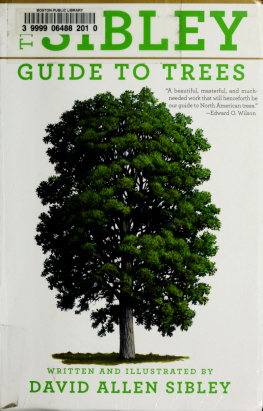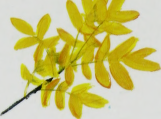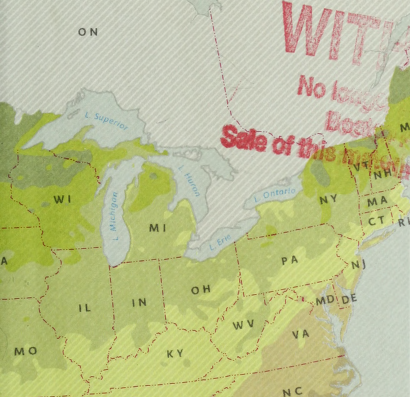
The Sibley guide to trees
Sibley, David, 1961 This book was produced in EPUB format by the Internet Archive. The book pages were scanned and converted to EPUB format automatically. This process relies on optical character recognition, and is somewhat susceptible to errors. The book may not offer the correct reading sequence, and there may be weird characters, non-words, and incorrect guesses at structure. Some page numbers and headers or footers may remain from the scanned page. The process which identifies images might have found stray marks on the page which are not actually images from the book.
The hidden page numbering which may be available to your ereader corresponds to the numbered pages in the print edition, but is not an exact match; page numbers will increment at the same rate as the corresponding print edition, but we may have started numbering before the print book's visible page numbers. The Internet Archive is working to improve the scanning process and resulting books, but in the meantime, we hope that this book will be useful to you. The Internet Archive was founded in 1996 to build an Internet library and to promote universal access to all knowledge. The Archive's purposes include offering permanent access for researchers, historians, scholars, people with disabilities, and the general public to historical collections that exist in digital format. The Internet Archive includes texts, audio, moving images, and software as well as archived web pages, and provides specialized services for information access for the blind and other persons with disabilities. $39-95Canada $45-00 DAVID ALLEN SIBLEY, the preeminentbird-guide author and illustrator, now applies hisformidable skills of identification and illustration tothe trees of North America. $39-95Canada $45-00 DAVID ALLEN SIBLEY, the preeminentbird-guide author and illustrator, now applies hisformidable skills of identification and illustration tothe trees of North America.
Monumental in scope butsmall enough to take into thefield, The Sibley Guide toTrees is an astonishinglyelegant guide to a complexsubject. It condenses a hugeamount of information about tree identification-more than has ever been collected in a singlebookinto a logical, accessible, easy-to-use format.With more than 4,100 meticulous, exquisitelydetailed paintings, the Guide highlights the oftensubtle similarities and distinctions between morethan 600 tree speciesnative trees as well as manyintroduced species. No other guide has ever madefield identification so clear. Features highlighted include:
| leaves | needles |
| (including | cones |
| multiple leaf | flowers |
| shapes and fall | fruit |
| leaf color) | twigs |
| bark | silhouettes |
More than 500 maps show the complete range, bothnatural and cultivated, for nearly all species. Trees are arranged taxonomically, with all relatedspecies grouped together. By focusing on thefundamental characteristics of, for example, oaks orchestnuts or hickories, the Guide helps the userrecognize these basic species groups the same waybirders recognize thrushes, warblers, or sparrows.
In addition, there are essays on taxonomy, onthe cultivation of trees, and on conservation issues,reflecting Sibley's deep concern with habitat preser-vation and environmental health. An important new contribution to our under-standing of the natural world, The Sibley Guide toTrees will be a necessity for every tree lover, veler, and naturalist. It is sure to become the new 'ichmark in field guides to trees. N V MB
SD NE KS OK TX
(d
Z Hudson Bay QC
tfS ^ TN M S sc GA LA FL Gulf of Mexico This map shows plant hardiness zones ofthe contiguous United States, as defined bythe United States Department of Agriculture(USDA) based on average minimum wintertemperatures. These zones provide a roughguide to the species of trees that might becultivated in your area. simple leavesLeaf arrangement
| Recognize patterns | Parts of a lobed palmate leaf |
| Use multiple field marks |
| Pay attention to habitat | Parts of a lobed pinnate leaf |
| Get to know your local trees | Compound palmate leaves |
| Meet other tree fans | Lobed pinnate leavesLobed palmate leaves |
| WHAT IS A TREE? | X |
| Definition of a tree | Compound pinnate leaves |
| Cultivated species | Compound bipinnate leavesOther leaf arangement |
| TAXONOMY | xi | Foliage textureLeaf color |
| Value of taxonomy |
| Taxonomic hierarchy | Underleaf |
| Higher groups of trees | Fall leaf color |
| Subgenera |
| FLOWERS | xxxi |
| Species | Flower structure |
| Hybridization |
| Subdivisions of species | Flower clusters |
| Names of trees | Male and female flowersPhenology |
| Common names |
| FRUIT | xxxiii |
| SIZE | xiv |
| Size and measurements | Gymnosperm Cones |
| Tree records | Angiosperm Fruit |
| TWIGS | XXXV |
| MAPS | XV |
| Zones | BUDS | xxxvi |
| Native or introduced? | BARK | xxxvii |
| HABITAT | xvii |
| TREE CONSERVATION | xvii | The Sibley Guide to Trees | |
| TREE IDENTIFICATION | xviii | YEW FAMILY | |
| Terminology | PINE FAMILY | |
| Variation | White pine group | |
| Growth form | Foxtail pine group | |
| Rate of growth | Pinyon group | |
| Longevity | Yellow pine group | |
| LEAVES | XX | True cedars | |
| Evergreen or deciduous | Larches | |
| Broadleaf vs. needle-leaf | Hemlocks | |
| Leaf size | Spruces | |
| Leafshape | Douglas-firs | |
| Variation in leaf shape | True firs | |
/'/ The Sibley Guide to Trees CYPRESS FAMILY Cypresses Junipers Other cypresses Redwood Giant SequoiaEXOTIC GYMNOSPERMSGINKGOPALM FAMILYJOSHUA TREESAGUAROLAUREL FAMILYCUSTARD-APPLE FAMILYMAGNOLIA FAMILYKATSURA FAMILYSYCAMORE FAMILYWITCH-HAZEL FAMILYSWEETGUM FAMILYTAMARISK FAMILYMYRTLE FAMILYLOOSESTRIFE FAMILYLEGUME FAMILYBAYBERRY FAMILYWALNUT FAMILY Hickories BIRCH FAMILY Birches Alders Hophornbeams Hornbeams Hazels BEECH FAMILY Beeches Chestnuts Oaks SPURGE FAMILY WILLOW FAMILY PoplarsWillows OLEASTER FAMILYMULBERRY FAMILYBUCKTHORN FAMILY
Next page
















